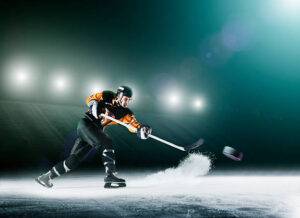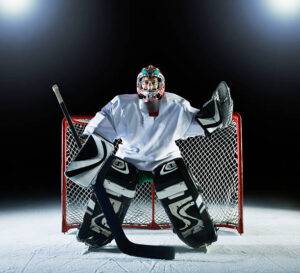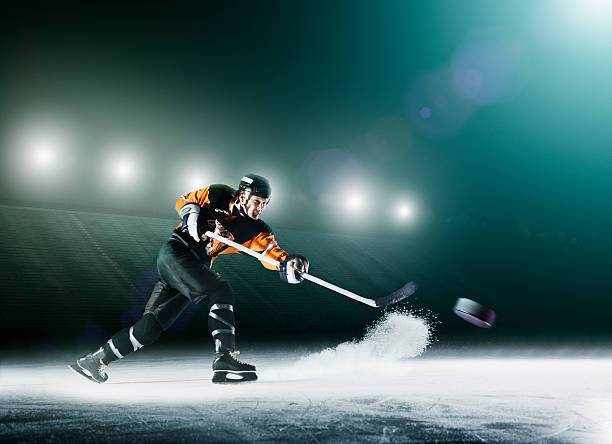Ice Hockey
Ice hockey is a fast-paced sport played on ice, involving two teams of skaters who use sticks to shoot a puck into the opponent’s goal. Players maneuver across the rink, passing the puck to teammates and defending against the opposing team’s attacks. The game is divided into three periods, each lasting 20 minutes, with teams aiming to score more goals than their opponents. Physical contact is a fundamental aspect, with body checking allowed within certain rules. Ice hockey requires speed, agility, teamwork, and strategy, making it an exhilarating and popular sport enjoyed by millions worldwide.

Ice hockey is a dynamic sport where two teams, each typically comprising six players, compete on an ice rink. The goal is to maneuver the puck past the opposing team’s goaltender and into the net.
The game is characterized by swift transitions, strategic maneuvers, and intense action, captivating audiences worldwide. It requires skillful skating, precise puck control, and effective teamwork, making ice hockey a thrilling and widely beloved sport.
History of Ice Hockey
The history of ice hockey might go back to games played with sticks and balls in the Middle Ages or even in ancient Greece and Egypt. Some people think it might have come from an old Irish game called hurling. But the exact start of ice hockey, like many other sports, is unclear.
Phil Pritchard, who works at the Hockey Hall of Fame in Toronto, says there’s a painting from the 1500s showing people playing something on ice that looks like hockey. They even had sticks back then
Ice hockey originates from a game played in Nova Scotia by the Mi’kmaq people. They used a stick called a “Hurley” and a square wooden block. This game likely spread across Canada through Scottish and Irish immigrants and the British army. Over time, it transformed into an informal ice game known as shinny or Shinty.
Ice Hockey originated in Canada in the early 19th century, inspired by similar sports played in Europe. The word “hockey” comes from the old French word “hocquet,” meaning “stick.” Around 1860, a puck replaced a ball, and in 1879, McGill University students Robertson and Smith created the first rules.
The first official team, the McGill University Hockey Club, was established in 1880, marking hockey as Canada’s national sport. In 1892, the Governor General of Canada donated the Stanley Cup, won first by the Montreal Amateur Athletic Association
Top 12 Rules of Ice Hockey Play
- Faceoffs – During a faceoff in ice hockey, all players position around one of five face-off circles on the ice. Only two players engage inside the circle. The faceoff’s location depends on the reason for the last stoppage in play, setting the stage for swift puck possession battles and strategic gameplay.
- Closing Hand on Puck – In ice hockey, if any player except the goaltender catches the puck, they must promptly drop it to the ice. Failing to do so results in a two-minute minor penalty. This rule prevents players from unfairly holding onto the puck, ensuring fair and continuous gameplay.
- Shootouts – In ice hockey, tied regular-season games after overtime go to a shootout. Each team takes turns attempting penalty shots, with three tries per side. If still tied, the shootout continues until one team fails to match the other. The shootout winner earns one goal, deciding the game’s outcome.
- Delay of Game – Actions leading to a delay of the game result in a two-minute minor penalty. These include deliberately shooting or batting the puck outside the playing area, moving the goal from its position intentionally, or failing to provide the correct number of players on the ice after an official warning or due to an illegal substitution.
- Icing the Puck – Icing in hockey happens when a player from their team’s side shoots the puck down the ice past the opposing goal line. It’s prohibited when teams are at equal strength or on a power play. Play stops, and a face-off occurs in the offending team’s zone. Exceptions include if the goalie plays the puck or if an official decides an opponent could have reached the puck. Additionally, the icing call may be waived if the official sees it as an attempted pass.
- Playing the puck with a high stick – If a player uses their stick above shoulder height to bat a puck, play stops, leading to a faceoff. Goals scored with such contact are disallowed. This rule ensures fair play and safety, preventing dangerous situations where players might be injured by high sticks or gain an unfair advantage.
- Overtime – In regular-season games, a tie at the end of regulation triggers a five-minute sudden-death overtime. If still tied, a shootout decides the winner. In playoffs, overtime periods last 20 minutes each, with no shootouts. This system ensures decisive outcomes in regular-season games while maintaining extended play for playoff matchups.
- Offsides – Offsides occur when an attacking player crosses the defending team’s blueline before the puck. The position of the player’s skate, not the stick, decides offsides. If both skates precede the puck over the blue line, it’s offsides. But if one skate is over and one touches the blue line, it’s onside. This rule aims to ensure fair play by preventing attackers from gaining an unfair advantage by being too far ahead of the play.
- Penalties – When players break game rules, officials may penalize them. Penalties come in three types: minor, major, and misconduct. Minor penalties mean two minutes in the penalty box with the team short-handed. They end if the opposing team scores during the power play. Major penalties entail five minutes in the box, lasting until the time ends. Misconduct penalties have varying durations.
- Power plays – Power plays occur when one team has more players on the ice due to an opponent serving a penalty.
- Penaltie Shots– Penalty shots are given when a player is tripped from behind on a breakaway or when the goalie or defenseman intentionally knocks the net off its moorings.
- Checking – Checking, the physical act of impeding an opponent’s play, is allowed throughout the ice rink. In leagues like the NHL, passing across two blue lines results in an offside call, leading to a face-off. Offside also occurs when players enter the attacking zone ahead of the puck. Face-offs are positioned where the infraction happened or near the attacking blue line. They also commence each period, after a goal, or any stoppage of play, ensuring fair game play.
Shot in Ice Hockey Play
In ice hockey, players utilize various shots: the powerful slap shot, the accurate wrist shot, and the quick backhander. Each has distinct techniques and purposes, offering players options to score goals or create scoring opportunities during gameplay.
- Slap Shot –
- Can reach speeds over 100 miles per hour (160 km/h).
- Involves bringing the stick back almost perpendicular to the ice, then swinging down in an arc to hit the puck.
- Less accurate compared to the wrist shot.
2. Wrist Shot
- Executed by placing the stick near the puck on the ice without a windup, and then snapping the wrist to shoot.
- Offers higher accuracy than the slap shot.
- Typically slower in speed compared to the slap shot.
3. Backhander
- Used when the puck is on the opposite side of the player’s usual shooting hand.
- Taken quickly when there’s insufficient time to shift the puck to the normal shooting position.
- Generally not as powerful or accurate as the wrist shot, but advantageous in rapid situations.
Equipment of Ice Hockey
Ice hockey equipment includes skates, helmets, shoulder pads, elbow pads, gloves, shin guards, and a stick. Goalies wear additional protective gear, such as leg pads, chest protectors, and a mask.
- Skates – Ice hockey skates are designed for rapid acceleration, speed, and agility, allowing players to start, stop, and change direction quickly. They need to be sturdy to protect against impacts from other players, sticks, pucks, and ice. Skaters adjust blade length, width, curvature, and hollow radius based on skill, position, and body type, typically around 1⁄8 inch (3.2 mm) thick.
- Protective gear – Protective gear is essential in men’s ice hockey due to its physical nature and allowance of body checks. Mandatory equipment includes helmets with visors or full face masks, shoulder and elbow pads, mouth guards, gloves, padded shorts or a girdle, athletic cups, shin pads, skates, and optionally, neck protectors. These ensure safety and reduce the risk of injuries during play.
- Goaltenders – Goaltenders wear specialized equipment due to the high speeds of hockey pucks. This includes goalie skates optimized for side-to-side movement, protective leg pads, a jock or jill, blocking and catching gloves, a chest protector, a goalie mask, and a large jersey. Their gear has grown over time, resulting in fewer goals per game and rule adjustments.

- Stick – The ice hockey stick features a long shaft with a slightly curved flat blade, used by all players except the goalie. The curve greatly affects performance, with a deep curve aiding in lifting the puck and a shallow one aiding in backhand shots. Stick flex also matters, with less flexibility suited for stronger players. Its unique design is ideal for hitting and controlling the puck, shaping the game’s early development.
- Helmets – Ice hockey helmets are essential safety gear, protecting players from head injuries during game play. They feature a hard outer shell and padding inside for impact absorption. Many helmets also include a face mask or visor to shield the face from pucks, sticks, and collisions. Properly fitting helmets are crucial for player safety on the ice.
- Shoulder Pads – Ice hockey shoulder pads are crucial protective gear, shielding players from impacts and collisions. They consist of hard plastic or foam padding covering the shoulders, chest, and upper arms, with straps to secure them in place. Shoulder pads absorb shocks and distribute impacts, reducing the risk of injuries like bruises, fractures, and dislocations during play.
- Elbow Pads – Ice hockey elbow pads are vital protective equipment, safeguarding players against impacts and falls. They feature hard plastic or foam padding covering the elbows, with straps to secure them in place. Elbow pads absorb shocks and distribute impacts, reducing the risk of injuries such as bruises, cuts, and fractures during gameplay.
- Gloves – Ice hockey gloves are essential protective gear for players, shielding their hands and wrists from impacts and injuries. They consist of padded gloves with reinforced palms and fingers, offering grip and protection while handling the stick and puck. Gloves allow players to maintain control and feel of the stick while ensuring safety during physical gameplay.
- Masks – In ice hockey, there’s no specific gear known as “elbow masks.” However, players may wear protective gear like elbow pads to shield their elbows from impacts and falls. These pads typically feature hard plastic or foam padding and are secured with straps to absorb shocks and reduce the risk of injuries during gameplay.
- Puck – A hockey puck, whether open or closed, serves as a vital component in various sports and games. Specifically crafted for use on ice or dry floors, these disks, typically made of vulcanized rubber, mimic the role of a ball in traditional games. Closed disk pucks, resembling short cylinders, dominate ice hockey arenas. Conversely, open disk variants, sporting a toroid shape, find their niche in floor hockey variations. It’s crucial not to conflate them with ringette rings, which differ in design and purpose. This discussion predominantly focuses on closed disk pucks, central to the essence of hockey sports and games

